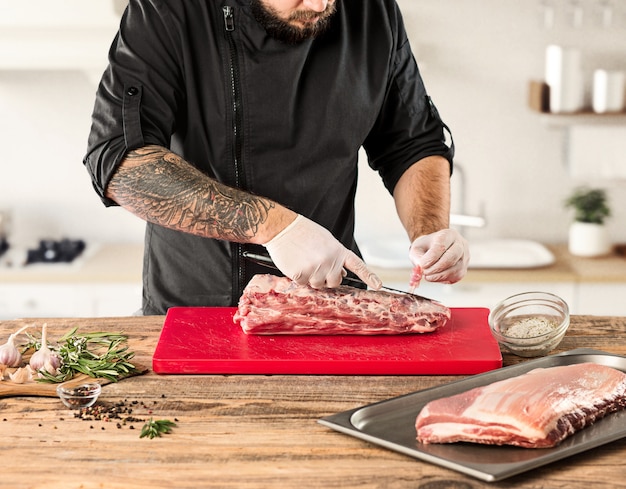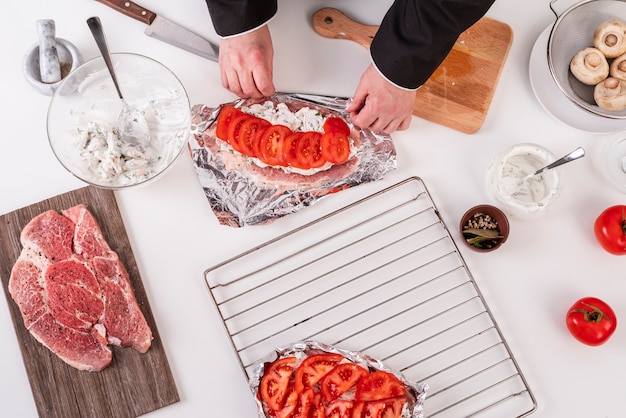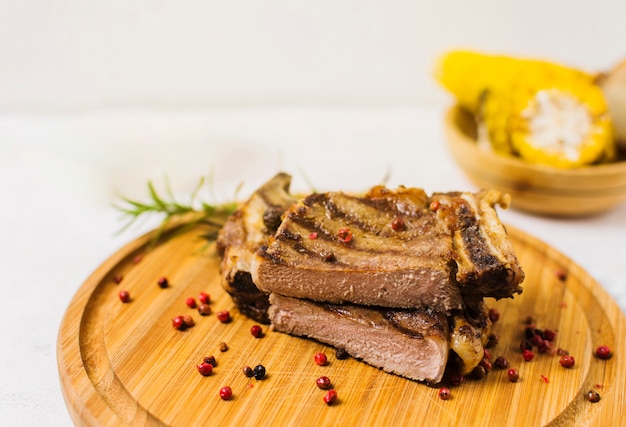Let's talk steak, shall we? And not just any steak, but rib eye. That magnificent cut with its beautiful marbling, promising juicy, flavourful bites that melt in your mouth. I've been a rib eye enthusiast for years, and I've spent countless hours honing my oven-baking technique, ensuring a consistently delicious outcome. No dry, overcooked disappointment here – just a symphony of juicy, tender perfection. Ready to embark on this culinary adventure with me? Grab a cuppa, get comfy, and let's get cooking!
(Part 1) choosing the right cut: The Foundation of a Great Steak

You know the saying, “You can't make a silk purse out of a sow's ear?" Well, the same goes for steak. A good steak starts with a good cut. For oven-baked rib eye, I always recommend a bone-in cut. That bone acts like a little flavour and moisture-retention champion, ensuring every bite is a delightful experience. And when it comes to thickness, aim for a hefty 1.5-2 inches – this allows for even cooking and beautiful results.
Tips for Picking the perfect rib eye
Marbling, Marbling, Marbling: Look for that beautiful web of white fat running through the meat. This is what makes rib eye so luscious and flavourful. It's the key to that melt-in-your-mouth texture.
A Firm Touch: A good rib eye should feel firm and springy, not mushy or limp. You want a cut that has been handled with care and hasn't been languishing in the fridge for too long.
Colour Counts: The meat should be a vibrant, deep red, not a dull brown or grey. A darker colour can indicate improper storage, so err on the side of caution.
(Part 2) Seasoning like a Pro: Elevating Your Steak to New Heights

Now, let's talk seasoning. We're not just throwing salt and pepper on here and calling it a day. We're about to unlock a world of flavour.
The Art of Seasoning: Mastering the Basics
Salt: The Unsung Hero: Kosher salt is my go-to for steak seasoning. It's coarse and dissolves beautifully, drawing out moisture and creating a more tender, flavourful steak. The key here is timing – salt your steak at least 30 minutes before cooking, allowing the salt to do its magic.
Black Pepper: The Classic Complement: Freshly ground black pepper adds a satisfying bite that perfectly balances the saltiness. Don't be afraid to use a generous amount!
Spicing Things Up: Don't be afraid to experiment with other spices! Garlic powder, onion powder, smoked paprika, a touch of chili flakes – the possibilities are endless. I personally love a little paprika for a subtle warmth and depth of flavour.
(Part 3) Prepping the Oven: Setting the Stage for Success

Your oven is about to play a crucial role in this culinary symphony, so let's make sure it's ready to shine.
Getting Your Oven Ready
Preheat, Preheat, Preheat: I cannot emphasize this enough. A preheated oven ensures even cooking, preventing uneven results and disappointment. Set your oven to a high temperature, around 450°F (230°C).
The Simplicity of a Baking Sheet: You don't need fancy equipment here. A simple baking sheet will do the trick.
Optional: The Wire Rack Advantage: To avoid direct contact with the baking sheet and promote even cooking, you can place a wire rack on top of the baking sheet. This allows for air circulation around the steak, preventing steaming and ensuring a beautiful crust.
(Part 4) Searing the Steak: A Touch of Magic
Now, it's time to bring out the big guns – the sear. This step gives your steak that iconic crust, locking in flavour and creating an irresistible aroma.
Searing Secrets
A Heavy-Bottomed Pan: For even heat distribution, choose a pan with a heavy base. Cast iron is a classic choice, but any sturdy pan will do.
Heat it Up, Baby!: Heat your pan over high heat until it's smoking hot. You want a searing-hot pan to create that beautiful crust.
Add the Steak with Confidence: Place the steak in the hot pan and cook for 2-3 minutes per side. You're aiming for a nice, even brown crust, not a burnt mess.
Avoid Overcrowding: If you're cooking multiple steaks, cook them in batches to ensure even browning and prevent overcrowding.
(Part 5) Into the Oven It Goes: Let the Oven Work its Magic
Now, it's time to let the oven take centre stage.
Oven Time: A Journey to Perfection
Transfer with Care: Carefully transfer the seared steak to the preheated oven. Remember to use oven mitts!
Cook to Your Liking: The cooking time will depend on the thickness of your steak and your desired level of doneness. Here's a general guide to keep in mind:
| Doneness | internal temperature (°F) | Cooking Time (minutes per side) |
|---|---|---|
| Rare | 125-130 | 8-10 |
| Medium Rare | 130-135 | 10-12 |
| Medium | 140-145 | 12-14 |
| Medium Well | 150-155 | 14-16 |
| Well Done | 160 | 16 |
Resting Time: A Crucial Step: Once the steak is cooked to your liking, remove it from the oven and let it rest for 10-15 minutes before slicing. This allows the juices to redistribute throughout the steak, resulting in a more tender, juicy cut.
(Part 6) The Finishing Touches: Elevating Your Steak to New Heights
We're in the home stretch now. Time to add those final touches that elevate your steak from good to truly sensational.
Time for the Extras: The Magic of Butter and Herbs
The Power of Butter: While the steak is resting, melt some butter in the same pan you seared it in. Add your favourite herbs, garlic, or lemon juice to the butter for a burst of flavour. I often use rosemary, thyme, or a combination of both for a fragrant, earthy note.
The Art of Basting: Once the steak has rested, pour the flavored butter over the steak. This keeps it moist and adds an extra layer of richness and flavour.
Serve with Pride: Serve your perfectly cooked rib eye with your favourite sides. mashed potatoes, asparagus, and a simple green salad always make a lovely accompaniment.
(Part 7) Doneness: A Guide for the Unsure
It's all about personal preference when it comes to doneness. But here's a simple guide to help you understand the different levels and choose the one that suits you best:
Understanding Doneness: Finding Your perfect steak
Rare: The inside of the steak will be very red, with a cool centre. It'll be exceptionally tender and juicy, ideal for those who appreciate a truly raw taste.
Medium Rare: The inside will be a vibrant red with a touch of pink, offering a balance of juiciness and tenderness. A popular choice for many steak lovers.
Medium: The inside will be mostly pink with a slight brown centre, offering a firmer texture with a hint of pink. A solid choice for those who prefer a little more cooked through.
Medium Well: The inside will be mostly brown with a small amount of pink, offering a more pronounced firmness with less juiciness. A good option for those who prefer a less raw centre.
Well Done: The inside will be completely brown, with no trace of pink, offering a very firm texture with minimal juiciness. For those who prefer their steak completely cooked through.
(Part 8) FAQs: The Steak Sceptics
You're ready to give this recipe a go, but you might have a few questions. Let's address them head-on!
FAQ: The Steak Sceptics
Q: How do I know if my steak is cooked to the right doneness without a thermometer?
A: You can use the finger test. Press on the centre of the steak. If it feels like the tip of your finger, it's rare. If it feels like the fleshy part of your thumb, it's medium-rare. And if it feels like the base of your thumb, it's medium. Remember, this is just a general guide, and everyone's fingers are different, so it's best to use a thermometer for more accurate results.
Q: What if my steak is overcooked?
A: Don't panic! A slightly overcooked steak can still be delicious. Just try to avoid overcooking it to the point where it becomes dry and tough. If it's too dry, you can try to remedy it by basting with some butter or sauce.
Q: Can I cook more than one steak at a time?
A: Yes, you can! Just make sure to cook them in batches if you need to, so you don't overcrowd the pan and prevent them from searing properly.
Q: What can I do with leftover steak?
A: Leftover steak is a culinary treasure! It's perfect for sandwiches, salads, or even a delicious steak and potato hash.
Q: What if I don't have a cast iron pan?
A: No problem. You can use any heavy-bottomed pan, such as stainless steel or even a non-stick pan. Just make sure it's preheated properly.
(Part 9) The Final Word: The Joy of a Perfect Steak
There you have it – a comprehensive guide to perfect oven-baked rib eye steak. I've shared my tried-and-true techniques, tips, and tricks to help you create a truly unforgettable steak experience. Remember, cooking is all about experimentation, so feel free to try different seasonings, herbs, and sauces to find your perfect combination. Now, grab your apron, open a bottle of your favourite wine, and let's celebrate the simple joy of a perfectly cooked steak! Happy cooking!
Everyone is watching

Prime Rib Roast Cooking Time Chart: Per Pound Guide
Cooking TipsPrime rib roast. Just the name conjures images of lavish dinners, crackling fires, and hearty laughter. It’s ...

How Long to Bake Potatoes in the Oven (Perfect Every Time)
Cooking TipsBaked potatoes are a staple in my kitchen. They're incredibly versatile, delicious, and surprisingly easy to m...

Perfect Rice Every Time: The Ultimate Guide to Cooking Rice
Cooking TipsAs a self-proclaimed foodie, I've always been a bit obsessed with rice. It's the foundation of countless cuisi...

The Ultimate Guide to Cooking Asparagus: Tips, Techniques, and Recipes
Cooking TipsAsparagus. The mere mention of this spring delicacy conjures up images of vibrant green spears, crisp and burs...

Ultimate Guide to Cooking the Perfect Thanksgiving Turkey
Cooking TipsThanksgiving. Just the word conjures up images of overflowing tables laden with delicious food, the scent of r...
